Simulation and Prediction of Land Use/Cover Changes Based on CLUE-S and CA-Markov Models: A Case Study of a Typical Pastoral Area in Mongolia
Abstract
1. Introduction
2. Study Area and Data Preprocessing
2.1. Study Area
2.2. Data Sources and Processing
3. Methodology
3.1. CLUE-S Model
3.2. CA-Markov Model
3.3. Suitability of Land Use
3.3.1. Logistic Regression Model Construction
3.3.2. Multi-Criteria Evaluation Analytical Hierarchy Process (MCE_AHP) Method
3.4. Models Validation
3.5. Scenario Design
4. Results
4.1. Land-Use Suitability
4.2. Models Validation
4.3. Spatiotemporal Characteristics and Analysis of LUCC in the Study Area from 2000 to 2019
4.4. Future Prediction of LUCC under Different Scenarios
4.4.1. Comparison and Analysis of Prediction Results of CLUE-S and CA_Markov Models under CT Development Scenario
4.4.2. Comparison and Analysis of Prediction Results of CLUE-S and CA_Markov Models under EP Development Scenario
5. Discussion
5.1. Comparison of Simulation Results between CLUE-S and CA_Markov Models
5.2. Sustainable Development of Pastoral Land Use under Different Scenarios
5.3. Limitations and Prospects
6. Conclusions
- 1.
- Taking each LULC and the average Kappa coefficient as the standard, both models could effectively simulate the LUCC pattern in 2019, and the simulation results of the CLUE-S model were significantly better than those of the CA_Markov model. Further analysis showed that the core part of the CLUE-S model was the spatial analysis module, which is characterized by finding the correlation between each LULC type and each driving factor through logistic regression analysis and using a systematic method to spatially indicate the competitive relationship between each LULC type. Therefore, the model can capture a wider range of LULC types (grassland, water, and other land) that are more dispersed and intensely transformed. The core part of the CA_Markov model considers neighborhood features; therefore, the model is more suitable for the LULC types of the nearest-neighbor change. This is also why the kappa coefficient of residential land is higher than that of the CLUE-S model. To sum up, the CLUE_S model is slightly better than the CA_Markov model in the simulation results of LUCC in typical pastoral areas with relatively slow economic development and low population density.
- 2.
- In the typical pastoral area of Gurvanbulag, from the LUCC situation from 2000 to 2019, the land types with increased area included arable land, grassland, residential land, and other land. Land types with decreasing areas included forest, road, and water. Further analysis of Figure 9 shows that LUCC in this area mainly occurs in the mutual transformation of three land types: grassland, water, and other land, among which grassland and other land increase by 26.81 km² and 31.84 km², respectively. The reduction in water is 54.19 km², which is the land type with the most serious reduction in the area, indicating that the region is at the risk of land resource degradation. It is imperative to formulate ecological environment protection and sustainable development policies.
- 3.
- Under the CT development scenario of the multi-scenario development model, the LUCC in this region will be dominated by the reduction of water and the increase in grassland and other land by 2030 and 2040. This indicates that the region will remain at risk of land resource degradation. In the degradation of land resources represented by other land use types (sandy land, saline-alkali land), the prediction result of CLUE_S is smaller than that of CA_Markov model, indicating that the former is more effective than the latter in combining the needs of local policies for sustainable development. Under the EP development scenario, the LUCC in this region is dominated by the mutual transformation of grassland (decrease) and other land (increase), and the other land area predicted by the CLUE-S model is smaller than that predicted by the CA_Markov model. This shows that the CLUE-S model can better meet the development needs of local policies than the CA_Markov model, in terms of suppressing land degradation. In conclusion, compared with the unconstrained CT development scenario, the EP development scenario is easier to achieve sustainable development of typical pastoral areas.
Author Contributions
Funding
Data Availability Statement
Acknowledgments
Conflicts of Interest
References
- Blumstein, M.; Thompson, J.R.; Nally, R.M. Land-use impacts on the quantity and configuration of ecosystem service provisioning in Massachusetts, USA. J. Appl. Ecol. 2015, 52, 1009–1019. [Google Scholar] [CrossRef]
- Hua, A.K. Application of Ca-Markov Model and Land Use/Land Cover Changes in Malacca River Watershed, Malaysia. Appl. Ecol. Environ. Res. 2017, 15, 605–622. [Google Scholar] [CrossRef]
- Aquilué, N.; De Cáceres, M.; Fortin, M.-J.; Fall, A.; Brotons, L. A spatial allocation procedure to model land-use/land-cover changes: Accounting for occurrence and spread processes. Ecol. Model. 2017, 344, 73–86. [Google Scholar] [CrossRef]
- Uhrqvist, O.; Lövbrand, E. Rendering global change problematic: The constitutive effects of Earth System research in the IGBP and the IHDP. Environ. Politics 2013, 23, 339–356. [Google Scholar] [CrossRef]
- Wang, Q.; Wang, H.; Chang, R.; Zeng, H.; Bai, X. Dynamic simulation patterns and spatiotemporal analysis of land-use/land-cover changes in the Wuhan metropolitan area, China. Ecol. Model. 2022, 464, 109850. [Google Scholar] [CrossRef]
- Li, D.; Wang, L. Sensitivity of Surface Temperature to Land Use and Land Cover Change-Induced Biophysical Changes: The Scale Issue. Geophys. Res. Lett. 2019, 46, 9678–9689. [Google Scholar] [CrossRef]
- Hamad, R.; Balzter, H.; Kolo, K. Predicting Land Use/Land Cover Changes Using a CA-Markov Model under Two Different Scenarios. Sustainability 2018, 10, 3421. [Google Scholar] [CrossRef]
- Zhou, L.; Dang, X.; Sun, Q.; Wang, S. Multi-scenario simulation of urban land change in Shanghai by random forest and CA-Markov model. Sustain. Cities Soc. 2020, 55, 102045. [Google Scholar] [CrossRef]
- Guan, D.; Zhao, Z.; Tan, J. Dynamic simulation of land use change based on logistic-CA-Markov and WLC-CA-Markov models: A case study in three gorges reservoir area of Chongqing, China. Environ. Sci. Pollut. Res. Int. 2019, 26, 20669–20688. [Google Scholar] [CrossRef]
- Verburg, P.H.; Neumann, K.; Nol, L. Challenges in using land use and land cover data for global change studies. Glob. Chang. Biol. 2011, 17, 974–989. [Google Scholar] [CrossRef]
- Zhou, R.; Zhang, H.; Ye, X.-Y.; Wang, X.-J.; Su, H.-L. The Delimitation of Urban Growth Boundaries Using the CLUE-S Land-Use Change Model: Study on Xinzhuang Town, Changshu City, China. Sustainability 2016, 8, 1182. [Google Scholar] [CrossRef]
- Santoso, E.B.; Aulia, B.U.; Desiana, T.A. Ecological Footprint Scenario Based on Dynamic System Model in Gerbangkertosusila Region. Int. Rev. Spat. Plan. Sustain. Dev. 2022, 10, 99–116. [Google Scholar] [CrossRef]
- Liao, G.; He, P.; Gao, X.; Lin, Z.; Huang, C.; Zhou, W.; Deng, O.; Xu, C.; Deng, L. Land use optimization of rural production–living–ecological space at different scales based on the BP–ANN and CLUE–S models. Ecol. Indic. 2022, 137, 108710. [Google Scholar] [CrossRef]
- Liu, X.; Liang, X.; Li, X.; Xu, X.; Ou, J.; Chen, Y.; Li, S.; Wang, S.; Pei, F. A future land use simulation model (FLUS) for simulating multiple land use scenarios by coupling human and natural effects. Landsc. Urban Plan. 2017, 168, 94–116. [Google Scholar] [CrossRef]
- Li, F.; Wang, L.; Chen, Z.; Clarke, K.C.; Li, M.; Jiang, P. Extending the SLEUTH model to integrate habitat quality into urban growth simulation. J Environ. Manag. 2018, 217, 486–498. [Google Scholar] [CrossRef]
- Ren, Y.; Lü, Y.; Comber, A.; Fu, B.; Harris, P.; Wu, L. Spatially explicit simulation of land use/land cover changes: Current coverage and future prospects. Earth-Sci. Rev. 2019, 190, 398–415. [Google Scholar] [CrossRef]
- Johnson, D.A.; Sheehy, D.P.; Miller, D.; Damiran, D. Mongolian rangelands in transition. Sci. Chang. Planétaires/Sécheresse 2006, 17, 133–141. [Google Scholar]
- Sneath, D. Land use, the environment and development in post-socialist Mongolia. Oxf. Dev. Stud. 2003, 31, 441–459. [Google Scholar] [CrossRef]
- Yang, Y.; Liu, Y.; Xu, D.; Zhang, S. Use of intensity analysis to measure land use changes from 1932 to 2005 in Zhenlai County, Northeast China. Chin. Geogr. Sci. 2017, 27, 441–455. [Google Scholar] [CrossRef]
- Huang, D.; Huang, J.; Liu, T. Delimiting urban growth boundaries using the CLUE-S model with village administrative boundaries. Land Use Policy 2019, 82, 422–435. [Google Scholar] [CrossRef]
- Wu, M.; Ren, X.; Che, Y.; Yang, K. A Coupled SD and CLUE-S Model for Exploring the Impact of Land Use Change on Ecosystem Service Value: A Case Study in Baoshan District, Shanghai, China. Environ. Manag. 2015, 56, 402–419. [Google Scholar] [CrossRef] [PubMed]
- Mokarram, M.; Pourghasemi, H.R.; Hu, M.; Zhang, H. Determining and forecasting drought susceptibility in southwestern Iran using multi-criteria decision-making (MCDM) coupled with CA-Markov model. Sci. Total Environ. 2021, 781, 146703. [Google Scholar] [CrossRef] [PubMed]
- Wang, R.; Derdouri, A.; Murayama, Y. Spatiotemporal Simulation of Future Land Use/Cover Change Scenarios in the Tokyo Metropolitan Area. Sustainability 2018, 10, 2056. [Google Scholar] [CrossRef]
- Nath, B.; Wang, Z.; Ge, Y.; Islam, K.; Singh, R.P.; Niu, Z. Land Use and Land Cover Change Modeling and Future Potential Landscape Risk Assessment Using Markov-CA Model and Analytical Hierarchy Process. ISPRS Int. J. Geo-Inf. 2020, 9, 134. [Google Scholar] [CrossRef]
- Mansour, S.; Al-Belushi, M.; Al-Awadhi, T. Monitoring land use and land cover changes in the mountainous cities of Oman using GIS and CA-Markov modelling techniques. Land Use Policy 2020, 91, 104414. [Google Scholar] [CrossRef]
- Fu, X.; Wang, X.; Yang, Y.J. Deriving suitability factors for CA-Markov land use simulation model based on local historical data. J Environ. Manag. 2018, 206, 10–19. [Google Scholar] [CrossRef]
- Dalantai, S.; Sumiya, E.; Bao, Y.; Otgonbayar, M.; Mandakh, U.; Batsaikhan, B.; Natsagdorj, B. Spatial-Temporal Changes of Land Degradation Caused by Natural and Human Induced Factors: Case Study of Bulgan Province in Central Mongolia. Int. Arch. Photogramm. Remote Sens. Spat. Inf. Sci. 2021, XLIII-B4-2021, 79–85. [Google Scholar] [CrossRef]
- Kakinuma, K.; Yanagawa, A.; Sasaki, T.; Rao, M.P.; Kanae, S. Socio-ecological Interactions in a Changing Climate: A Review of the Mongolian Pastoral System. Sustainability 2019, 11, 5883. [Google Scholar] [CrossRef]
- Wang, Q.; Liu, R.; Men, C.; Guo, L. Application of genetic algorithm to land use optimization for non-point source pollution control based on CLUE-S and SWAT. J. Hydrol. 2018, 560, 86–96. [Google Scholar] [CrossRef]
- Verburg, P.H.; Eickhout, B.; van Meijl, H.J. A multi-scale, multi-model approach for analyzing the future dynamics of European land use. Ann. Reg. Sci. 2008, 42, 57–77. [Google Scholar] [CrossRef]
- Gong Wenfeng, Y.L.; Wenyi, F. Land use change and forecast in Harbin based on CA-Markov. Chin. J. Agric. Eng. 2012, 28, 8. [Google Scholar] [CrossRef]
- Liu, S.; Yu, Q.; Wei, C. Spatial-Temporal Dynamic Analysis of Land Use and Landscape Pattern in Guangzhou, China: Exploring the Driving Forces from an Urban Sustainability Perspective. Sustainability 2019, 11, 6675. [Google Scholar] [CrossRef]
- Shu, B.; Zhang, H.; Li, Y.; Qu, Y.; Chen, L. Spatiotemporal variation analysis of driving forces of urban land spatial expansion using logistic regression: A case study of port towns in Taicang City, China. Habitat Int. 2014, 43, 181–190. [Google Scholar] [CrossRef]
- Zhai, Y.; Yao, Y.; Guan, Q.; Liang, X.; Li, X.; Pan, Y.; Yue, H.; Yuan, Z.; Zhou, J. Simulating urban land use change by integrating a convolutional neural network with vector-based cellular automata. Int. J. Geogr. Inf. Sci. 2020, 34, 1475–1499. [Google Scholar] [CrossRef]
- Baatar. Development Trend of Mongolian Agriculture and Animal Husbandry. World Agric. 1999, 16–18. [Google Scholar]
- Ren, Y.; Li, Z.; Li, J.; Ding, Y.; Miao, X. Analysis of Land Use/Cover Change and Driving Forces in the Selenga River Basin. Sensors 2022, 22, 1041. [Google Scholar] [CrossRef]
- Rafiei Sardooi, E.; Azareh, A.; Mesbahzadeh, T.; Soleimani Sardoo, F.; Parteli, E.J.R.; Pradhan, B. A hybrid model using data mining and multi-criteria decision-making methods for landslide risk mapping at Golestan Province, Iran. Environ. Earth Sci. 2021, 80, 487. [Google Scholar] [CrossRef]
- Basse, R.M.; Omrani, H.; Charif, O.; Gerber, P.; Bódis, K. Land use changes modelling using advanced methods: Cellular automata and artificial neural networks. The spatial and explicit representation of land cover dynamics at the cross-border region scale. Appl. Geogr. 2014, 53, 160–171. [Google Scholar] [CrossRef]
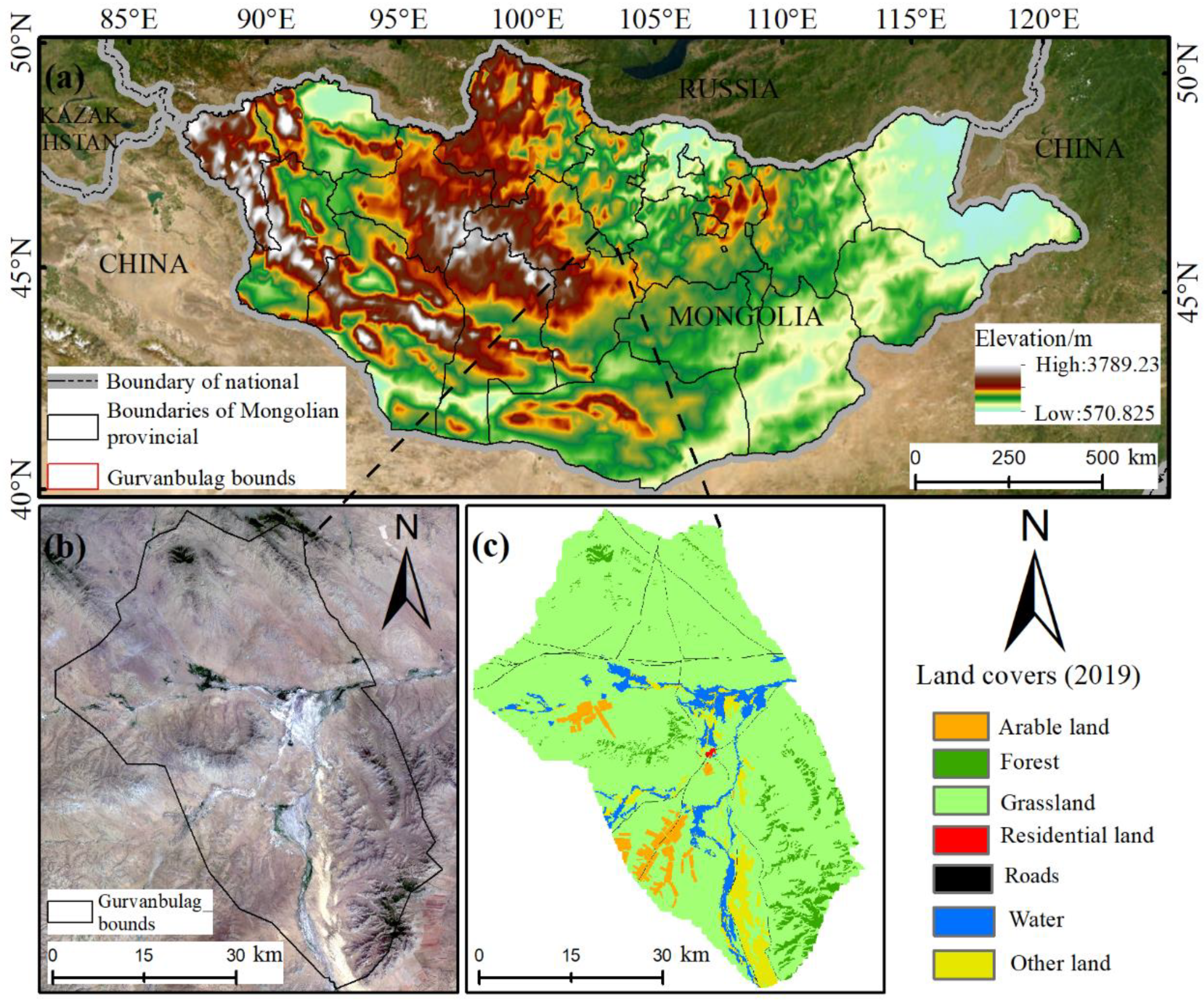
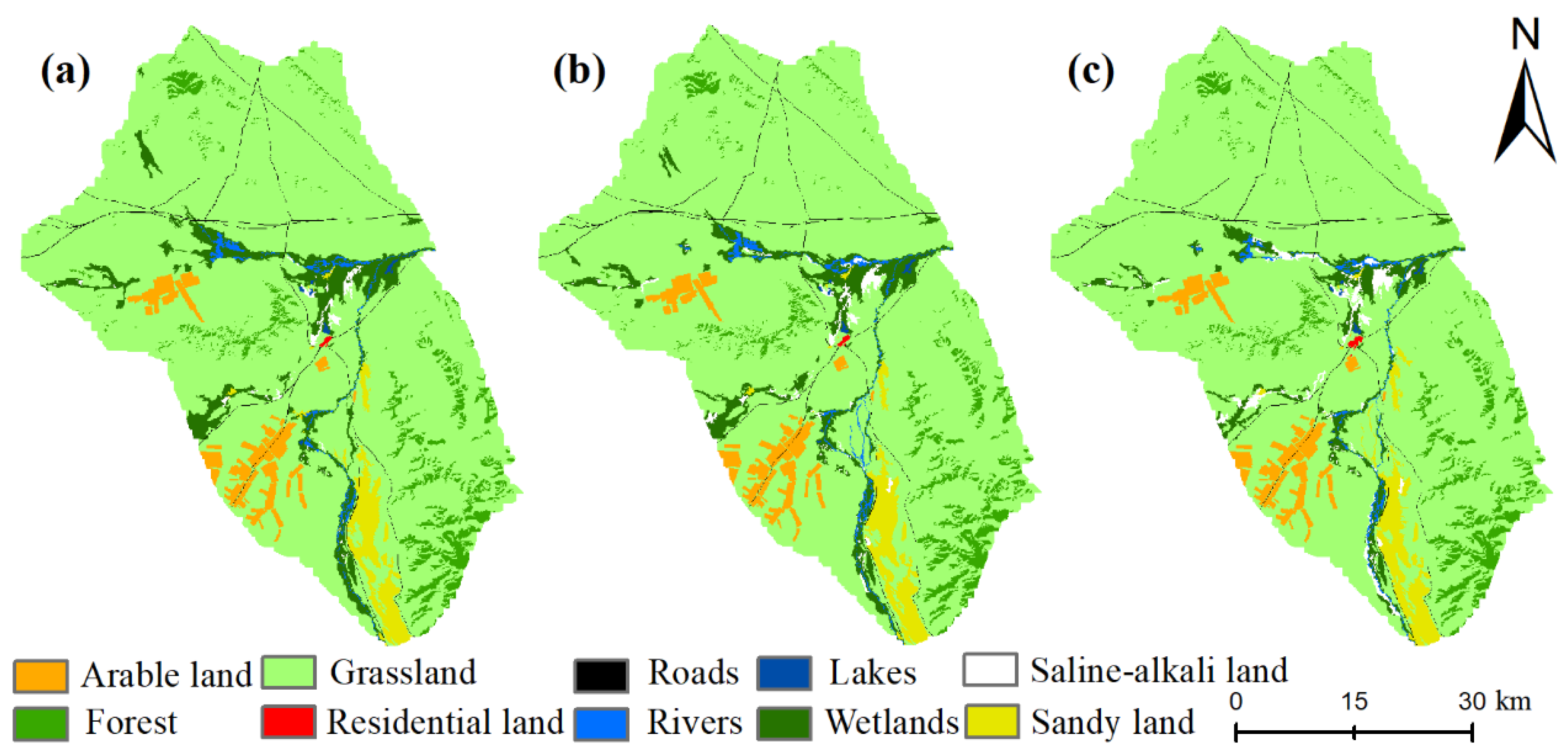


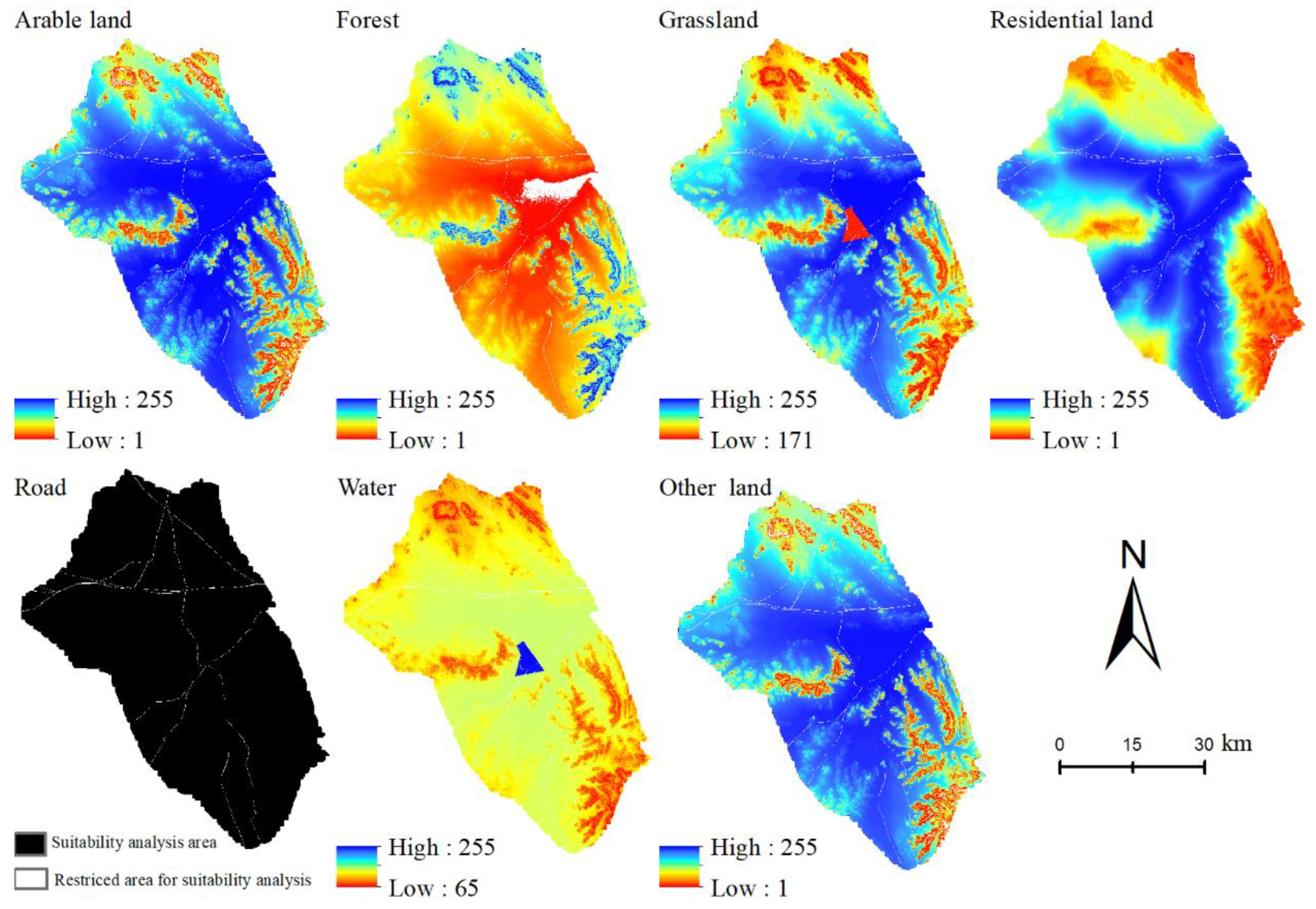
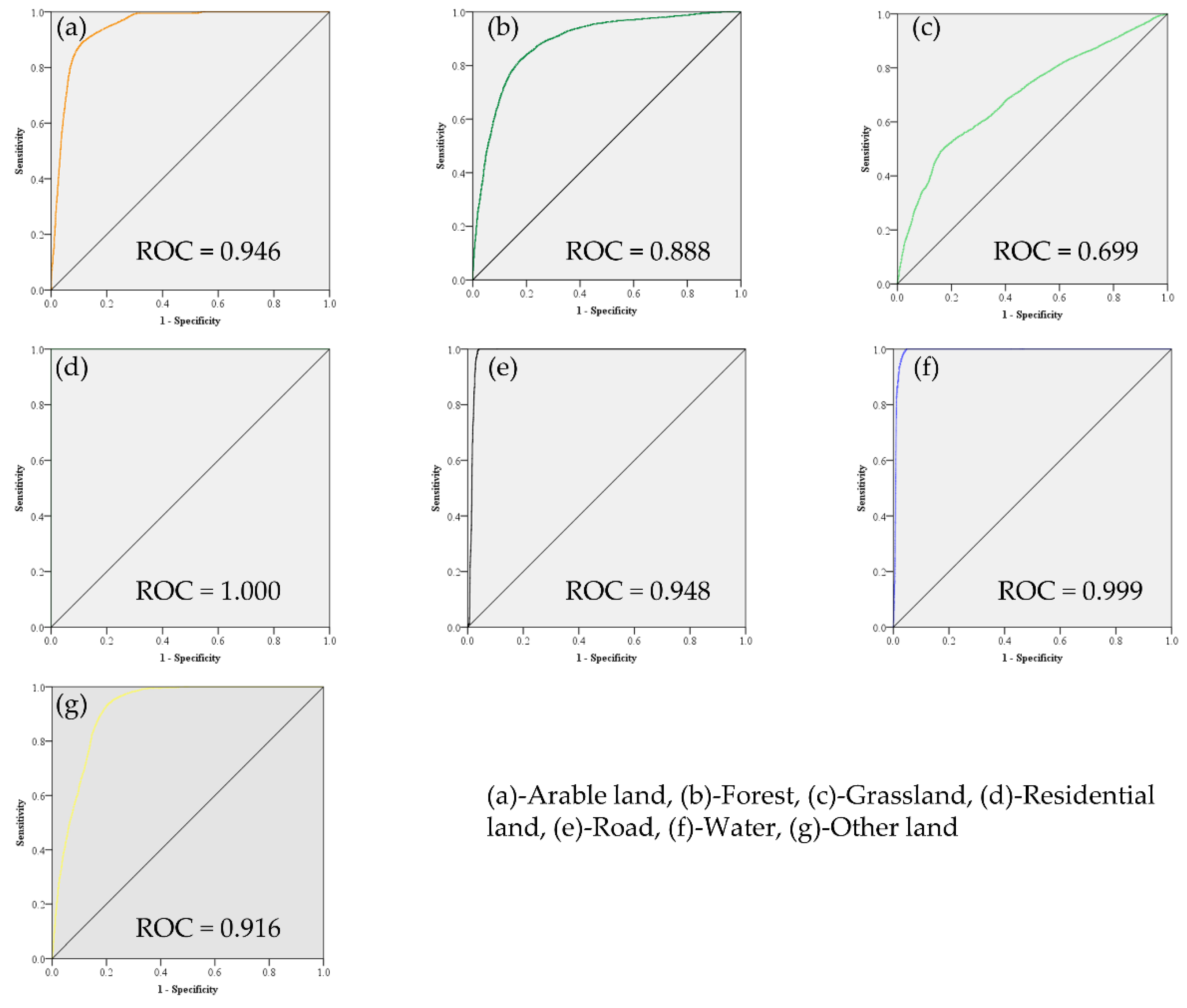
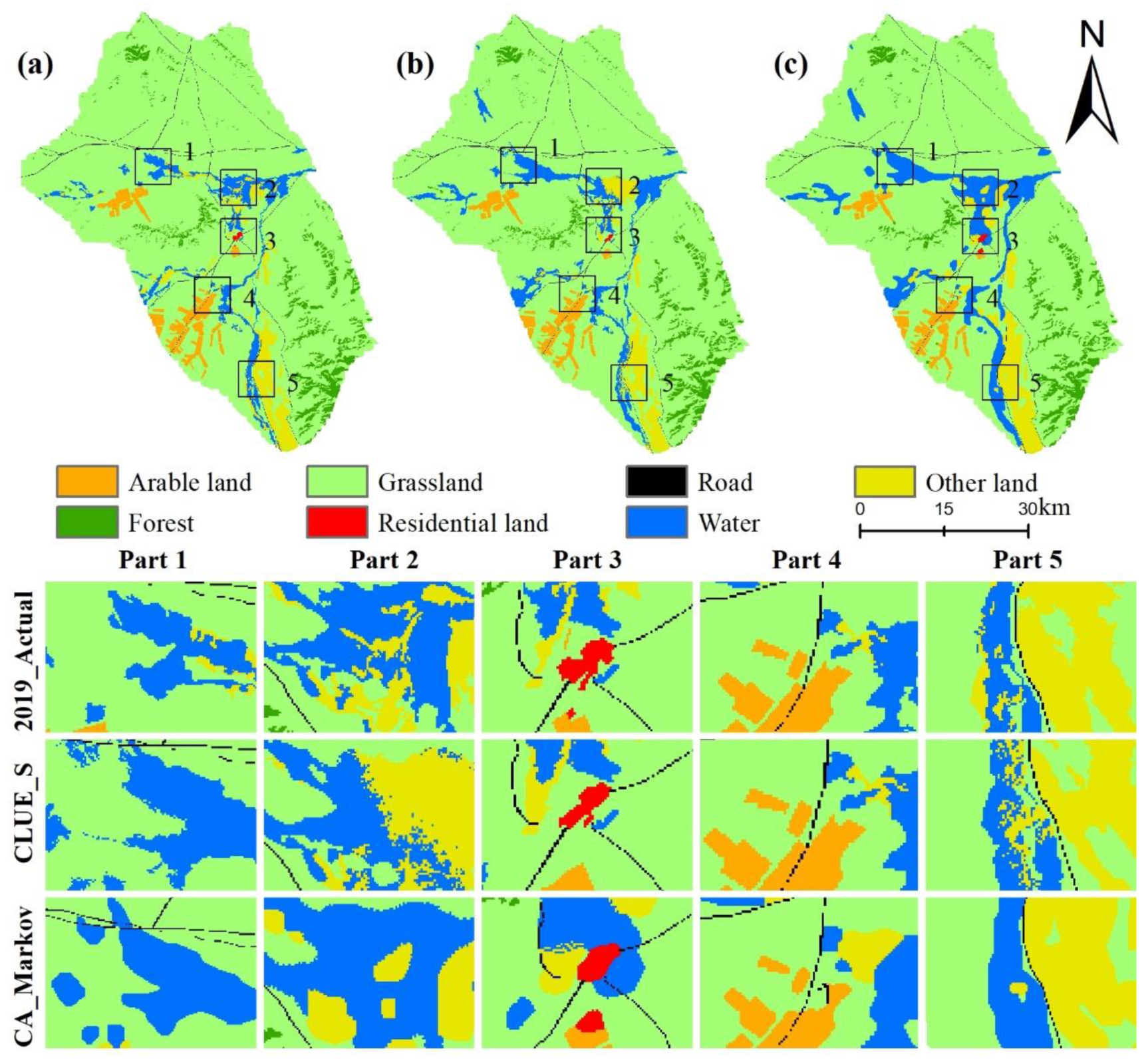
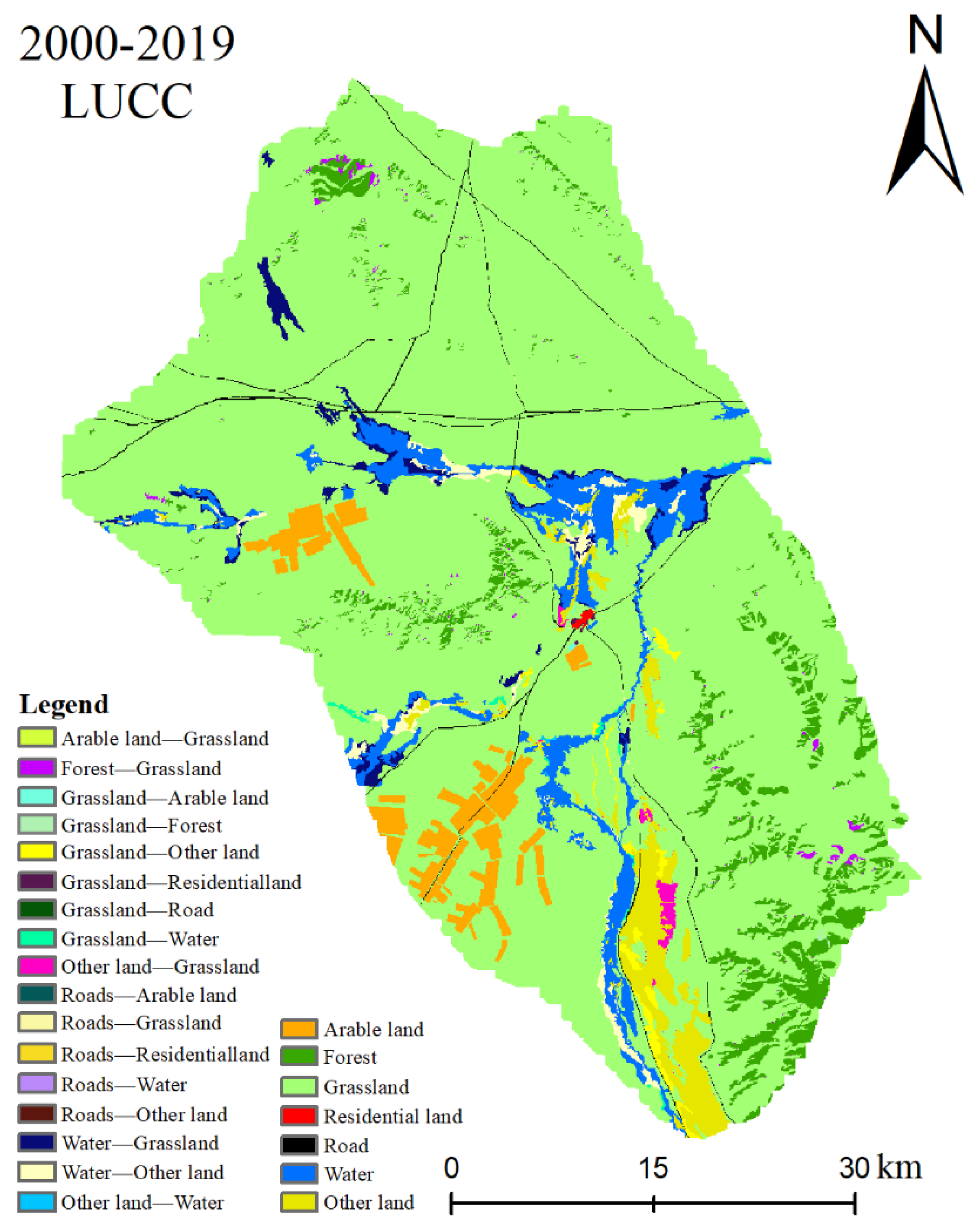

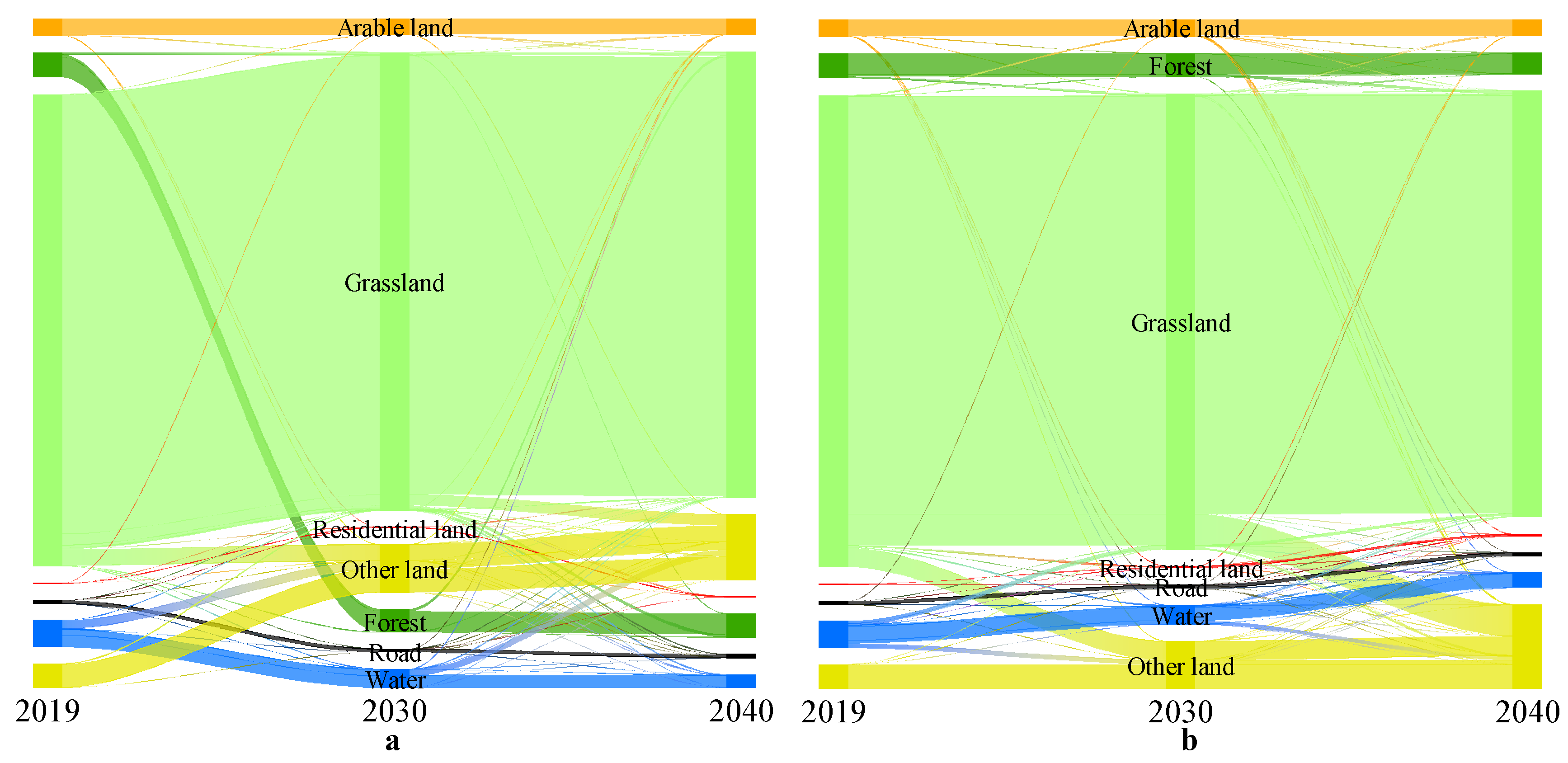


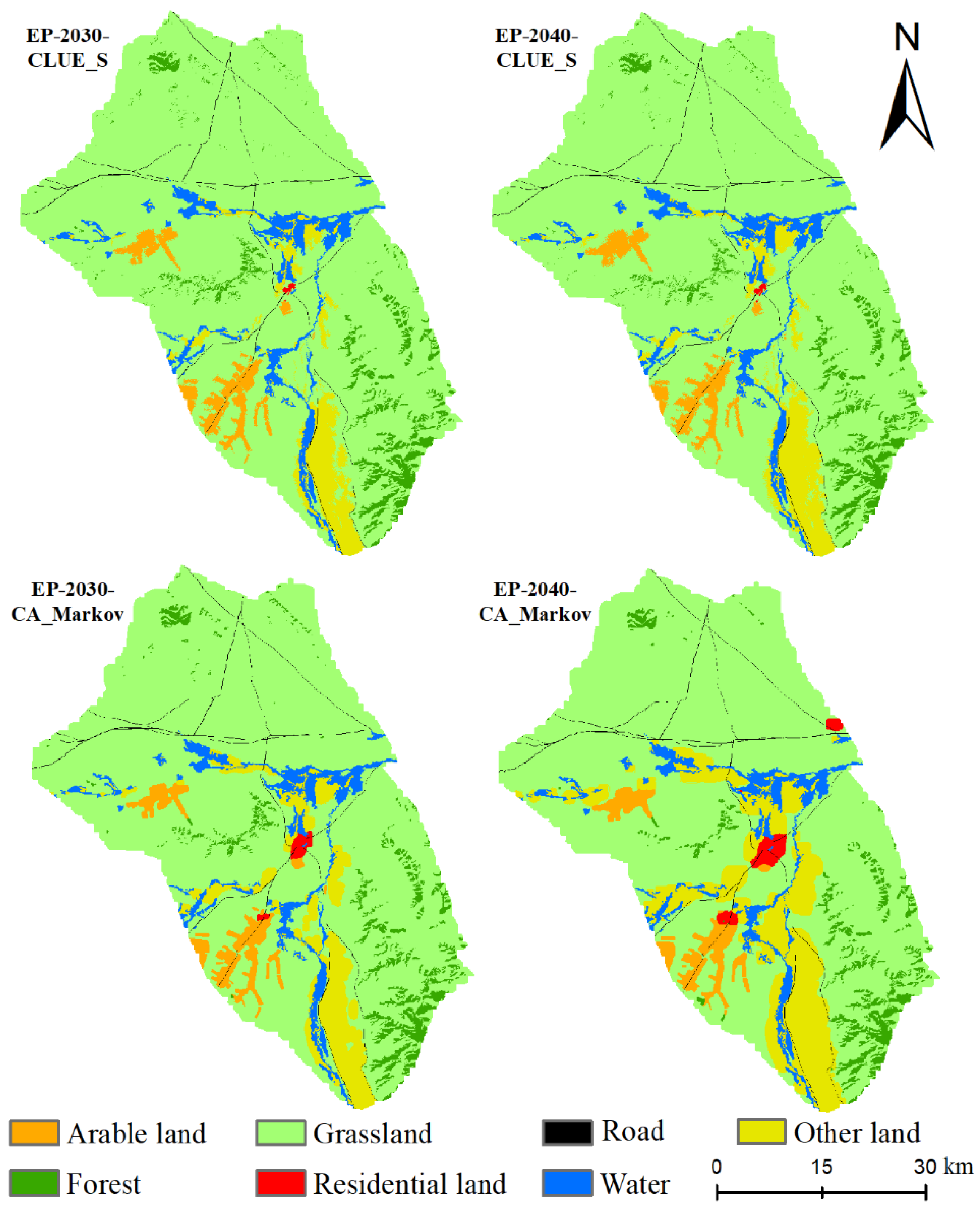
| Category | Data | Year | Data Resource |
|---|---|---|---|
| Images | Landsat TM/OLI | 2000–2019 | https://earthexplorer.usgs.gov/ (accessed on 25 April 2020) |
| Terrain | DEM/Aspect/Slope | - | https://earthexplorer.usgs.gov/ (accessed on 6 December 2020) |
| Statistical Yearbook data | Actual land use area | 2000–2014 | Mongolian Institute of Geography |
| Weather station data | Temperature/Precipitation | 2000–2019 | Mongolian Institute of Geography |
| Social statistics | Average population density/Average livestock density | 2000–2019 | 1212.mn |
| Scenario | Arable | Forest | Grassland | Residential Land | Road | Water | Other Land | |
|---|---|---|---|---|---|---|---|---|
| 2010–2019 | 0.6 | 0.6 | 0.1 | 1 | 0.8 | 0.1 | 0.1 | |
| 2019–2030–2040 | CT | 0.6 | 0.6 | 0.1 | 1 | 0.8 | 0.1 | 0.1 |
| EP | 0.6 | 0.8 | 0.3 | 1 | 0.8 | 1 | 0.1 |
| Driving Factor | Arable Land | Forest | Grassland | Residential Land | Road | Water | Other Land |
|---|---|---|---|---|---|---|---|
| Dem | 0.005(−) | 0.071(+) | 0.006(−) | - | 0.013(+) | 0.068(−) | 0.005(−) |
| Slope | 0.004(+) | 0.084(+) | 0.019(+) | - | - | - | 0.009(−) |
| Aspect | - | 0.006(+) | - | - | - | - | 0.001(+) |
| Distance to Residential | - | - | - | 0.044(−) | - | - | - |
| Distance to Road | - | - | - | - | 0.073(−) | - | - |
| Distance to Water | - | - | - | - | - | 0.165(−) | - |
| Population density | 0.889(−) | - | 0.543(+) | 0.956(+) | - | - | 0.739(−) |
| Livestock Density | 0.016(−) | - | 0.029(−) | - | - | - | 0.034(+) |
| Precipitation | 0.087(−) | 0.839(−) | 0.403(+) | - | 0.913(−) | 0.769(−) | 0.212(−) |
| LULC Types | CLUE-S | CA_Markov |
|---|---|---|
| Arable land | 0.995892 | 0.963588 |
| Forest | 0.95716 | 0.90314 |
| Grassland | 0.920865 | 0.809894 |
| Residential land | 0.66656 | 0.749774 |
| Road | 1 | 1 |
| Water | 0.71242 | 0.624952 |
| Other land | 0.714328 | 0.679071 |
| Average Kappa | 0.852461 | 0.818631 |
| 2019 2000 | Arable | Forest | Grassland | Residential Land | Road | Water | Other Land | All |
|---|---|---|---|---|---|---|---|---|
| Arable | 78.81 | - | 0.27 | - | - | - | - | 79.08 |
| Forest | - | 112.53 | 9.11 | - | - | - | - | 121.64 |
| Grassland | 0.46 | 4.32 | 2155.18 | 0.59 | 0.42 | 4.00 | 13.17 | 2178.14 |
| Residential land | - | - | - | 1.02 | - | - | - | 1.03 |
| Road | 0.04 | - | 0.84 | 0.01 | 15.86 | 0.03 | 0.04 | 16.81 |
| Water | - | - | 33.43 | - | 0.02 | 118.98 | 25.48 | 177.92 |
| Other land | - | - | 6.12 | - | - | 0.73 | 73.81 | 80.66 |
| All | 79.31 | 116.85 | 2204.95 | 1.62 | 16.30 | 123.73 | 112.50 | 2655.26 |
Publisher’s Note: MDPI stays neutral with regard to jurisdictional claims in published maps and institutional affiliations. |
© 2022 by the authors. Licensee MDPI, Basel, Switzerland. This article is an open access article distributed under the terms and conditions of the Creative Commons Attribution (CC BY) license (https://creativecommons.org/licenses/by/4.0/).
Share and Cite
Sun, C.; Bao, Y.; Vandansambuu, B.; Bao, Y. Simulation and Prediction of Land Use/Cover Changes Based on CLUE-S and CA-Markov Models: A Case Study of a Typical Pastoral Area in Mongolia. Sustainability 2022, 14, 15707. https://doi.org/10.3390/su142315707
Sun C, Bao Y, Vandansambuu B, Bao Y. Simulation and Prediction of Land Use/Cover Changes Based on CLUE-S and CA-Markov Models: A Case Study of a Typical Pastoral Area in Mongolia. Sustainability. 2022; 14(23):15707. https://doi.org/10.3390/su142315707
Chicago/Turabian StyleSun, Changqing, Yulong Bao, Battsengel Vandansambuu, and Yuhai Bao. 2022. "Simulation and Prediction of Land Use/Cover Changes Based on CLUE-S and CA-Markov Models: A Case Study of a Typical Pastoral Area in Mongolia" Sustainability 14, no. 23: 15707. https://doi.org/10.3390/su142315707
APA StyleSun, C., Bao, Y., Vandansambuu, B., & Bao, Y. (2022). Simulation and Prediction of Land Use/Cover Changes Based on CLUE-S and CA-Markov Models: A Case Study of a Typical Pastoral Area in Mongolia. Sustainability, 14(23), 15707. https://doi.org/10.3390/su142315707







